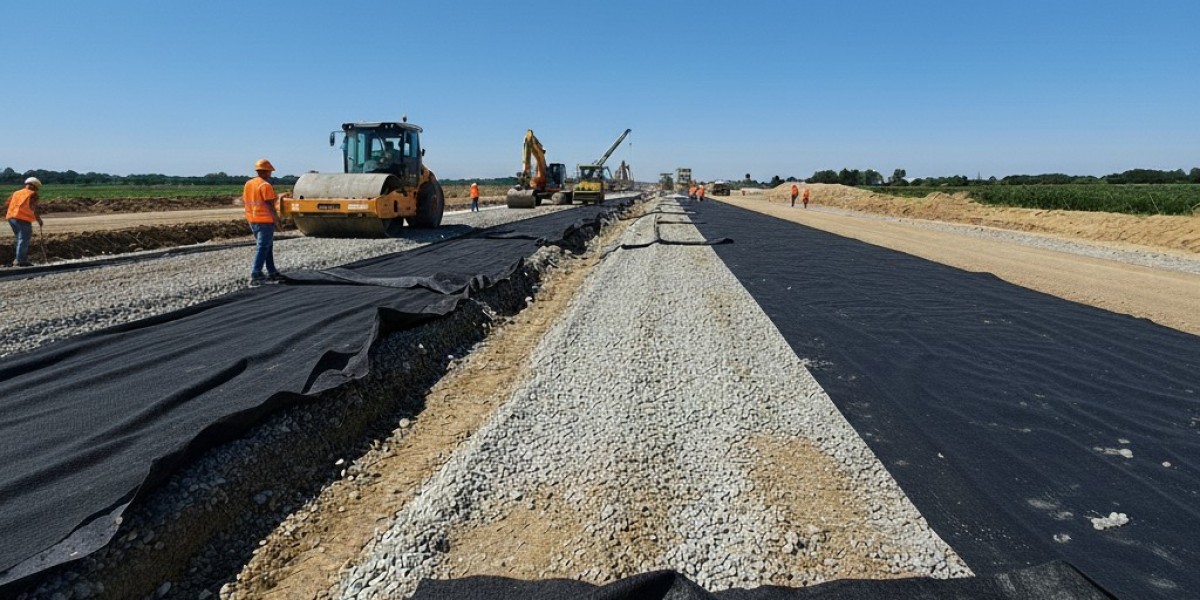The Role of Soil Stabilization Fabric in Durable Road Construction and Heavy-Load Infrastructure
Road construction and infrastructure development are increasingly challenged by the need for durability, cost efficiency, and environmental compliance. As traffic volumes increase and construction standards rise, engineers and contractors are turning to innovative solutions to ensure long-lasting road performance. Among these solutions, soil stabilization fabric has emerged as a critical component for building durable, resilient roadways capable of withstanding heavy loads, variable soil conditions, and extreme weather.
This blog provides a technical and practical guide to soil stabilization fabric, highlighting its applications in road construction, key specifications, benefits, and best practices for clients seeking high-quality solutions.
What is Soil Stabilization Fabric?
Soil stabilization fabric is a specialized geosynthetic material, typically made from woven or non-woven polypropylene or polyester fibers, designed to improve soil strength and stability. By reinforcing weak soil layers, it reduces deformation, prevents erosion, and enhances load-bearing capacity—key requirements for road and infrastructure projects.
Unlike traditional soil reinforcement techniques, which often rely on mechanical compaction or chemical stabilizers, soil stabilization fabric integrates seamlessly with the natural soil structure, providing long-term durability without compromising environmental sustainability.
Applications in road construction include:
- Reinforcing subgrades for highways and rural roads
- Preventing rutting and settlement in heavy-traffic areas
- Improving drainage while maintaining soil separation
- Stabilizing embankments and slopes
The fabric’s adaptability to various soil types and project scales makes it a preferred choice for civil engineers and contractors managing large infrastructure projects.
Geotextile in Road Construction
A closely related solution is the use of geotextile in road construction, which encompasses non-woven fabrics designed for soil reinforcement, filtration, drainage, and separation. While soil stabilization fabric primarily focuses on improving strength and load-bearing capacity, geotextiles offer additional functionality, particularly in managing water flow and preventing subgrade contamination.
Key benefits of geotextiles in road construction:
- Allow water to drain while retaining soil particles
- Reduce the risk of potholes and uneven settlement
- Extend the life of paved and unpaved roads
- Minimize maintenance costs over the lifecycle of the road
Many projects combine soil stabilization fabric and geotextiles to achieve comprehensive road reinforcement solutions. This integration ensures both structural stability and effective water management—critical factors in long-term road performance.
Benefits of Soil Stabilization Fabric for Road Projects
Decision-makers consider several factors when selecting soil reinforcement solutions: durability, cost efficiency, installation ease, and regulatory compliance. Soil stabilization fabric addresses all of these needs:
1. Enhanced Load-Bearing Capacity
One of the primary advantages is its ability to distribute loads evenly across weak subgrades. For highways, industrial roads, and airports, this property reduces rutting and prolongs pavement life, ensuring that roads handle heavy traffic and machinery without structural failure.
2. Improved Soil Separation and Drainage
When installed between different soil layers, soil stabilization fabric acts as a separation barrier, preventing intermixing of aggregates and subsoil. This improves drainage, reduces waterlogging, and prevents premature deformation—a key concern for regions with heavy rainfall or fluctuating water tables.
3. Erosion Control
Slopes, embankments, and roadside verges are prone to erosion from wind, rain, and surface runoff. Soil stabilization fabric reinforces these areas, maintaining soil integrity while supporting vegetation growth for additional stabilization.
4. Cost Efficiency
By reducing the need for repeated maintenance, expensive excavation, or chemical soil stabilizers, soil stabilization fabric offers long-term cost savings for contractors and municipal agencies. Its lightweight design also reduces transportation and handling costs, particularly for large-scale road projects.
5. Environmental Compliance
Unlike chemical stabilizers or lime-based methods, high-quality soil stabilization fabrics are non-toxic, recyclable, and compatible with sustainable construction standards. This feature makes them attractive for clients who must meet environmental regulations in public and private projects.
Key Specifications for Heavy-Load Road Applications
Clients evaluating soil stabilization fabrics must consider specific technical parameters to ensure project success. These specifications often include:
- Tensile Strength: Indicates the fabric’s ability to withstand loads without tearing; critical for high-traffic roads.
- Elongation: Determines flexibility and adaptability to uneven subgrades.
- Permeability: Ensures proper drainage while maintaining soil retention.
- GSM (Grams per Square Meter): Reflects fabric density and durability.
- UV Resistance: Essential for outdoor applications with prolonged sun exposure.
- Width and Roll Length: Must match project requirements to optimize installation efficiency.
High-quality fabrics meet or exceed ASTM and ISO standards, ensuring consistent performance and compliance with road construction regulations.
Installation Guidelines and Best Practices
Correct installation is essential to maximize the benefits of soil stabilization fabric in road construction. Key steps include:
1. Site Preparation
- Excavate and level the subgrade
- Remove debris, stones, and vegetation
- Ensure proper compaction to avoid uneven settling
2. Fabric Placement
- Roll the fabric along the alignment of the road
- Overlap adjacent rolls according to manufacturer guidelines (typically 10–15 cm)
- Ensure no folds or wrinkles, which may reduce performance
3. Aggregate Layering
- Cover the fabric with aggregate layers (crushed stone or gravel)
- Compact each layer progressively to achieve maximum soil reinforcement
- Maintain proper drainage slope for water management
4. Quality Checks
- Verify tensile strength and coverage after installation
- Inspect overlaps and anchoring to prevent displacement
- Conduct performance tests (bearing capacity, rutting resistance) as needed
By following these steps, projects can achieve optimal performance, minimize future maintenance, and ensure project longevity.
Choosing the Right Manufacturer for Road Projects
Selecting a reliable supplier is critical for large-scale infrastructure projects. Clients should consider manufacturers who offer:
- Proven track record in heavy-load road and infrastructure applications
- Global quality certifications (ISO, ASTM)
- Customized solutions for specific traffic loads and soil conditions
- On-time delivery and support for large-volume projects
- Technical support for installation and project consultation
Manufacturers like Anita Plastics specialize in producing high-performance soil stabilization fabrics and geotextiles in road construction, providing both technical guidance and supply chain reliability for contractors, civil engineering firms, and government agencies.
Applications in Road Infrastructure
- Highways and Expressways: Soil stabilization fabric reinforces subgrades under high traffic volumes, preventing rutting and pavement deformation.
- Industrial Roads and Logistics Hubs: Heavy machinery and vehicle traffic are supported efficiently, extending service life and reducing maintenance cycles.
- Rural and Unpaved Roads: Stabilization fabric ensures better gravel retention, reduces erosion, and enhances load-bearing capacity for agricultural and local transport roads.
- Airport Runways: High tensile-strength fabrics maintain uniform subgrade strength under extreme load conditions, ensuring operational safety and compliance with aviation standards.
Why Soil Stabilization Fabric is Essential for Road Construction
Investing in high-quality soil stabilization fabric is essential for cost-effective, durable, and environmentally compliant road projects. By improving load distribution, enhancing drainage, preventing erosion, and ensuring compliance with industry standards, these fabrics directly impact the lifecycle performance of roads and heavy-load infrastructure.
Partner with manufacturers who provide technical support, project-specific specifications, and consistent supply. Proper fabric selection strengthens infrastructure and optimizes ROI.
Ensure your road construction projects achieve maximum durability and efficiency. Contact us today to discuss project-specific soil stabilization fabric and geotextile solutions, bulk supply options, and technical guidance from experienced manufacturers.






